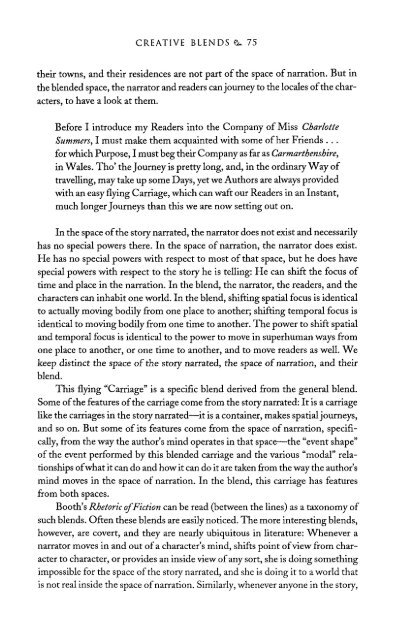The Literary Mind.pdf
The Literary Mind.pdf
The Literary Mind.pdf
Create successful ePaper yourself
Turn your PDF publications into a flip-book with our unique Google optimized e-Paper software.
CREATIVE BLENDS 75<br />
their towns, and their residences are not part of the space of narration. But in<br />
the blended space, the narrator and readers can journey to the locales of the characters,<br />
to have a look at them.<br />
Before I introduce my Readers into the Company of Miss Charlotte<br />
Summers, I must make them acquainted with some of her Friends . . .<br />
for which Purpose, I must beg their Company as far as Carmarthenshire,<br />
in Wales. Tho' the Journey is pretty long, and, in the ordinary Way of<br />
travelling, may take up some Days, yet we Authors are always provided<br />
with an easy flying Carriage, which can waft our Readers in an Instant,<br />
much longer Journeys than this we are now setting out on.<br />
In the space of the story narrated, the narrator does not exist and necessarily<br />
has no special powers there. In the space of narration, the narrator does exist.<br />
He has no special powers with respect to most of that space, but he does have<br />
special powers with respect to the story he is telling: He can shift the focus of<br />
time and place in the narration. In the blend, the narrator, the readers, and the<br />
characters can inhabit one world. In the blend, shifting spatial focus is identical<br />
to actually moving bodily from one place to another, shifting temporal focus is<br />
identical to moving bodily from one time to another. <strong>The</strong> power to shift spatial<br />
and temporal focus is identical to the power to move in superhuman ways from<br />
one place to another, or one time to another, and to move readers as well. We<br />
keep distinct the space of the story narrated, the space of narration, and their<br />
blend.<br />
This flying "Carriage" is a specific blend derived from the general blend.<br />
Some of the features of the carriage come from the story narrated: It is a carriage<br />
like the carriages in the story narrated—it is a container, makes spatial journeys,<br />
and so on. But some of its features come from the space of narration, specifically,<br />
from the way the author's mind operates in that space—the "event shape"<br />
of the event performed by this blended carriage and the various "modal" relationships<br />
of what it can do and how it can do it are taken from the way the author's<br />
mind moves in the space of narration. In the blend, this carriage has features<br />
from both spaces.<br />
Booth's Rhetoric of Fiction can be read (between the lines) as a taxonomy of<br />
such blends. Often these blends are easily noticed. <strong>The</strong> more interesting blends,<br />
however, are covert, and they are nearly ubiquitous in literature: Whenever a<br />
narrator moves in and out of a character's mind, shifts point of view from character<br />
to character, or provides an inside view of any sort, she is doing something<br />
impossible for the space of the story narrated, and she is doing it to a world that<br />
is not real inside the space of narration. Similarly, whenever anyone in the story,















